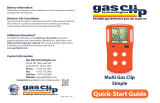GasAlertMicroClip
Quick Reference Guide
4
• Sur cet appareil, seule la détection de gaz combustibles
a fait l’objet d’une évaluation des performances par
CSA International.
• Veillez à effectuer l'étalonnage dans une zone sûre,
exempte de gaz dangereux, et dans une atmosphère
contenant 20,9 % d'oxygène.
• Si le capteur de gaz combustibles a été exposé à des
contaminants/poisons (composés de soufre, vapeurs de
silicium, produits halogénés, etc.), il est conseillé de
vérifier son bon fonctionnement en le mettant en
présence d'une concentration connue d'un gaz.
• Avant chaque utilisation quotidienne, BW recommande
d’effectuer un test fonctionnel des capteurs afin de
vérifier qu’ils réagissent bien aux gaz présents, en
exposant le détecteur à une concentration de gaz
supérieure aux seuils d’alarme. Vérifiez manuellement
que les alarmes sonore et visuelle sont activées.
Étalonnez l’appareil si les relevés ne sont pas
conformes aux limites spécifiées.
• Mise en garde : Des relevés élevés hors échelle peuvent
indiquer la présence d’une concentration explosive.
• Toute mesure en rapide augmentation suivie d’une
diminution ou d’une mesure fantaisiste peut indiquer
une concentration de gaz au-delà de la limite d’échelle
supérieure, risquant donc d’être dangereuse.
• Une exposition prolongée du GasAlertMicroClip XT à
certaines concentrations de gaz combustibles et dans
certaines atmosphères peut nuire à l'élément de
détection et altérer gravement ses performances.
Étalonnez le détecteur après toute exposition à des
concentrations élevées de gaz combustibles ayant
déclenché son alarme. Si nécessaire, remplacez le
capteur.
• Protégez le capteur de gaz combustibles contre toute
exposition aux composés de plomb, aux silicones et
aux hydrocarbures chlorés.
• L'exposition du capteur à certaines vapeurs organiques
(comme l'essence au plomb ou les hydrocarbures
halogénés) peut altérer temporairement son bon
fonctionnement. Il est recommandé de procéder à un
test fonctionnel ou à un étalonnage après toute
exposition.
• Cet appareil est destiné uniquement à une utilisation
dans des atmosphères potentiellement explosives,
dans lesquelles la concentration d’oxygène ne dépasse
pas 20,9 % (v/v).
• Les produits peuvent contenir des matériaux qui sont
réglementés pour le transport en vertu des règlements
nationaux et internationaux de marchandises
dangereuses. Retourner le produit conformément à la
réglementation sur les marchandises dangereuses
appropriées. Contactez transporteur de fret pour plus
d'instructions





















